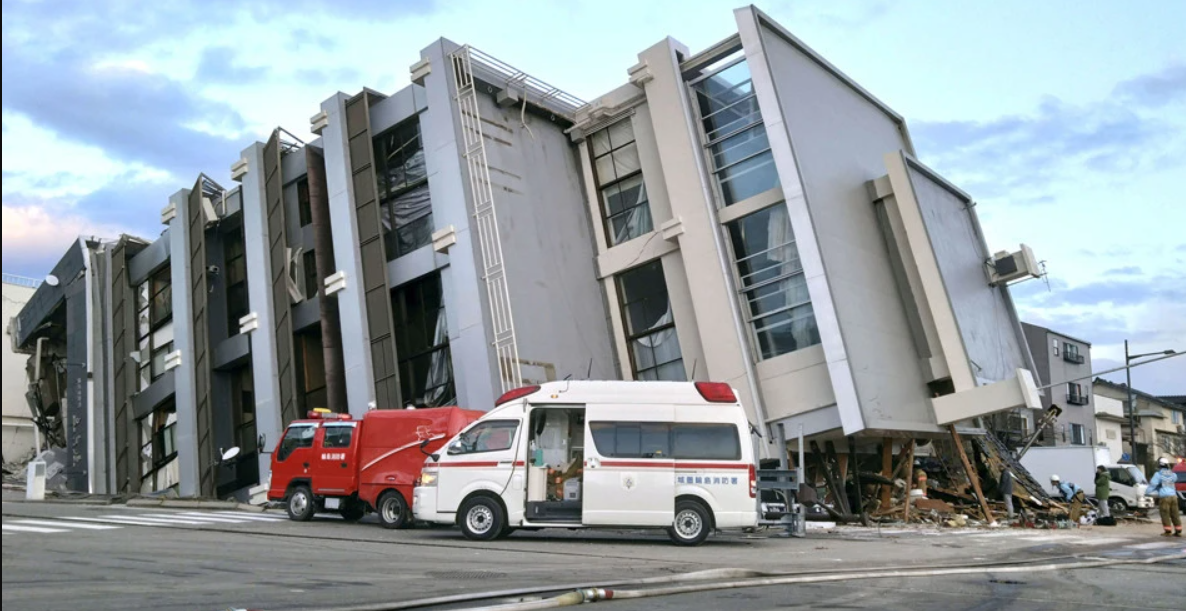
On Monday, January 1, a powerful earthquake hit Japan, killing more than 100 people. Search operations are ongoing, and there may still be victims under the rubble. The amount of losses reached $6.4 billion. This was reported by Reuters.
As of Saturday morning, January 6, more than 30,000 evacuees are waiting for help, and the search for survivors under the rubble has been going on for six days. This is the deadliest earthquake in the country in almost eight years.
According to the Ishikawa prefectural government, by 13:00 (04:00 GMT), 16 more deaths were confirmed in the cities of Wajima and Anamizu, bringing the total death toll to 110.
As of January 5, 94 people were reported dead.
The United States said it is preparing military logistical support and assistance for the regions of Japan devastated by the earthquake.
Japan is in talks with the US about emergency aid and has so far rejected offers of assistance from other countries, including China.
“We are not accepting any human or material assistance from other countries or regions at this time, given the situation on the ground and the efforts required to receive it,” said Japan’s chief spokesman Yoshimasa Hayashi.
According to the American disaster modeling company Karen Clark & Co (KCC), the damage from the devastating earthquake in Japan could reach 6.4 billion US dollars.
According to the KCC, residential property damage accounts for more than two-thirds of the total, as most commercial and industrial buildings in the affected cities are more earthquake-resistant due to their predominantly steel construction.
The new data as of January 5 was reported by Kyodo agency.
In Ishikawa Prefecture, 92 people were reported dead. Another 242 people are looking for them.
The city of Wajima has the highest number of victims, and rescuers fear that the number of victims will rise again. About 4600 people are involved in the rescue operation. Critical infrastructure is being repaired in the cities of Wajima and Suzu.
Also, as a result of the earthquake and tsunami, more than 10 national highways were blocked by landslides.
The data as of the morning of January 4 at was published by Xinhua.
As of Thursday morning, the death toll in the central Japanese prefecture of Ishikawa has risen to 78. Also about 95 thousand. of residents still do not have access to centralized water supply.
Japanese Prime Minister Fumio Kishida said that the rescue operation is now at a critical point.
“More than 40 hours have passed since the disaster. It is a race against time. We have received information that many people are still waiting to be rescued under the rubble,” Kishida said.
Search and rescue operations are significantly hampered by damaged roads and rubble.
“After Monday’s earthquakes, at least 100 hectares in Ishikawa were flooded by the tsunami, but a larger area is likely to be flooded in total,” the agency writes;
The increase in the number of victims is reported by Kyodo News.
Thus, as of Wednesday, January 3, at least 64 people are known to have died. Municipal authorities reported that they had received information about several cases of people buried alive under the rubble.
In addition, the Japan Meteorological Agency has warned of potential landslides due to the predicted rains.
Reuters reports on the earthquake relief efforts as of January 2.
The earthquake on the Noto Peninsula has sent 3,000 rescuers from across the country – military personnel, firefighters and police officers – to the site of the earthquake.
“Searching for and rescuing earthquake victims is a race against time,” Prime Minister Fumio Kishida said during an emergency meeting.
Kishida said that it is very difficult for rescuers to access the northern tip of the Noto Peninsula, where helicopters have found many fires and significant damage to buildings and infrastructure. According to a spokesman for his government, about 120 people are waiting to be rescued.
Many railroad connections and flights in the area were suspended. Noto Airport closed due to damage to the runway, terminal and access roads, and 500 people were stuck in cars in its parking lot.
In Suzu, a coastal city with a population of more than 5 thousand. According to the mayor of the city, Masuhiro Izumiya, up to 1,000 homes were destroyed in the town located near the epicenter of the earthquake houses.
“The situation is catastrophic,” he emphasized.
Authorities have confirmed 30 deaths, half of them in Wajima, another affected town on the remote northern tip of the peninsula.
According to the Japanese Disaster Management Agency, firefighters are battling the fire in several cities and trying to free people trapped under the rubble of buildings.
According to the Japan Meteorological Agency, which warned that even stronger tremors could occur in the coming days, more than 140 aftershocks have been recorded since the first quake on Monday.
Later, the Ishikawa disaster relief headquarters reported that the number of victims of the earthquake had increased to 48,reports BBC.
According to officials, the number may increase as rescue efforts continue.
Japan’s Chief Cabinet Secretary Yoshimasa Hayashi said after an emergency government meeting that Prime Minister Fumio Kishida had instructed to “put life first” and “understand the situation” with the destruction caused by the earthquake.
“Residents of Japan, please be prepared for earthquakes of up to seven magnitude within a week,” he emphasized. – “People living in areas where strong tremors have been felt, please follow evacuation information through local offices, television, radio and the Internet and take appropriate action.
Hayashi emphasized that there are 120 “cases of people” waiting to be rescued, and then added that “a total of 57,360 people have been evacuated.”
As a reminder, a 7.6 magnitude earthquake struck on Monday, January 1, in the afternoon, forcing residents of some coastal areas to flee to higher ground as tsunami waves hit the west coast of Japan, washing away some cars and homes.

